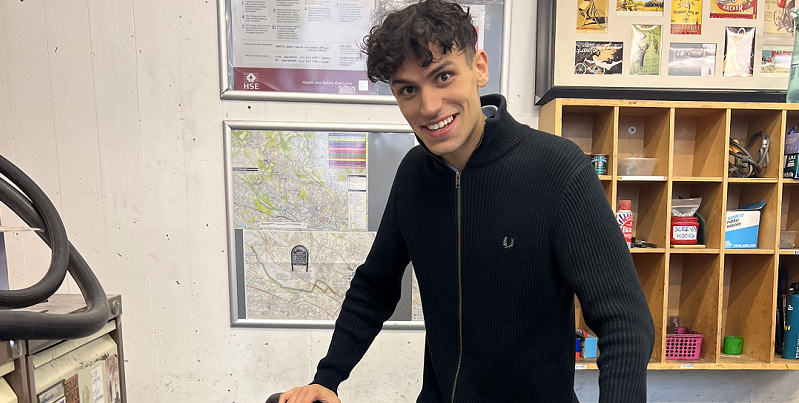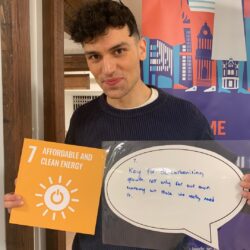Calculating Scope 3 emissions as a Sustainability intern

Hi, my name’s David and I’m the Sustainability Projects Assistant in the Sustainability Service at the University of Leeds.
I took the opportunity to do a one year campus internship between the second and third years of my Economics and Geography degree, and have been working in the Sustainability Service since last September.
As a Projects Assistant I’ve had the chance to get experience working across a few different areas of sustainability. This includes reducing single use plastics, and the University’s Blueprint sustainability programme, where the Sustainability Service support staff to design and deliver sustainability plans in their areas of work.
I’ve really valued the variety of different projects I have been able to get involved in. This breadth of experiences, plus working alongside such a friendly team has made it a great learning experience.
Emissions, scopes and the Climate Plan
A big project I’ve worked on recently has been calculating the University’s scope 3 emissions. This is an industry term where greenhouse gas emissions are categorised into ‘scopes’.
Scope 1 and 2 emissions are those from fuel directly used by the organisation (such as in vehicles or gas boilers) or associated with the electricity that is purchased and used.
Scope 3 includes everything else that the University is indirectly responsible for, but which might not be in our direct control. An example is the products and services that the University purchases.
For most organisations scope 3 is the largest set of emissions, and the most challenging to calculate. Because we don’t know the actual emissions associated with everything we buy or use, the typical approach is to use conversion factors to calculate scope 3 emissions based on the data we do have, such as product category and spend, or travel type and distance.
The University’s Climate Plan includes scope 3 business travel and commuting emissions in its target to deliver net zero by 2030. Business travel includes travel for things like carrying out research, for academic conferences and student field trips. However, staff and student commuting relates to travel to and from the University campus (or other place of work) from their term time address. This is the section of scope 3 emissions that I have mostly been working on, and it’s been both really interesting and challenging!
Mental gymnastics 1: commuting emissions
To calculate staff and student commuting emissions, we use an annual travel survey. This is a set of questions asking how often, how far, and with what mode of transport people travel to campus (or wherever they are based for work/study). We then do a bit of mental gymnastics using conversion factors provided by the Department for Energy Security and Net Zero (previously ‘BEIS’) to work out the emissions from this travel.
One of the things I’m working on at the moment is how we can improve the response rates to the survey for this year, so that we can be confident that the data is robust. A challenge we’ve had with the data in the past is that when we have smaller numbers of respondents – which was the case for the student survey in the last academic year - a handful of people making higher emission commutes in the survey can lead to big differences in the final emission figures that might not be reflective of reality.
A key part of this is simplifying the survey, keeping it as short and easy to complete as possible whilst also making sure we have all the essential data we need to be able to calculate the emissions. Hopefully whoever takes over this project next year will have a much more straightforward job to do as a result!
For the first time this year we’ll be including questions about travel between Leeds and students’ non-term time addresses at the start and end of term. We don’t currently have any data for this, so by including the new questions we’ll be able to make a first estimate of emissions for this type of travel.
We’ll be launching the travel survey after Easter, so keep an eye open for it and make sure you fill it in, whether you are staff or a student!
Mental gymnastics 2: business travel emissions
Our business travel emissions are calculated through a mix of internal and external sources that can vary widely in quality!
For staff who travel to conferences and for research, travel should all be booked through the University’s travel provider ‘Key Travel’. The University has guidance on choosing sustainable travel, and Key Travel are able to help identify the lower emission routes to take, whilst also recording all the information we need to be able to calculate emissions. Although this data has its own idiosyncrasies, generally it’s manageable for calculating travel emissions.
Despite this, some travel ends up being booked directly and claimed for through the expenses system. This system isn’t designed to make carbon calculations from, so you have to do quite a bit of gymnastics to make it work and to sense check the data. Top tip for helping out future sustainability interns – if you need to travel for work then book through Key Travel wherever you can!
There was also lots of vehicle hire data to work through. Generally we could get pretty accurate data for these, although one notable exception is coach hire. The conversion factors are not designed to look at hire of whole coaches, instead looking at emissions for individual passengers. Again, some mental gymnastics to be done there, whilst we look for better solutions.
Think you could do my job?

The scope 3 project in particular has been a thoroughly interesting exercise. Getting proper data is vital to actually achieving net zero. This project has made that clear to me and It’s been a great learning experience trying to solve the problems the data throws up.
Sustainability is a broad church. Blueprint, another area I’ve been able to get involved, works in many different areas across the university, from laboratories to print, all facing bespoke challenges on sustainability. Thinking though these issues with them has been really engaging. There’s so much more that the Sustainability Service does that you have the chance to get involved in too, such as the Student Sustainability Research Conference that was held in March.
Recruitment is currently open for our 2023/24 intake of placement students. There are two campus internship roles available, which are open to current 2nd / penultimate year undergraduate students at the University of Leeds. Take a look at the job descriptions and get your application in now!
Keep up to date on the latest news
-
-
- Follow us on Twitter: @UoL_Sus
- Follow us on Instagram: @uol_sus
- Follow us on Facebook: @UoLSustainability
- Sign up to our Sustainability newsletter
-
United Nations Sustainable Development Goals
 We use the United Nations Sustainable Development Goals (SDGs) as a framework to guide our activity. Our work on Student Citizenship links to all of the SDGs.
We use the United Nations Sustainable Development Goals (SDGs) as a framework to guide our activity. Our work on Student Citizenship links to all of the SDGs.
Find out more about our impact on the SDGs.
